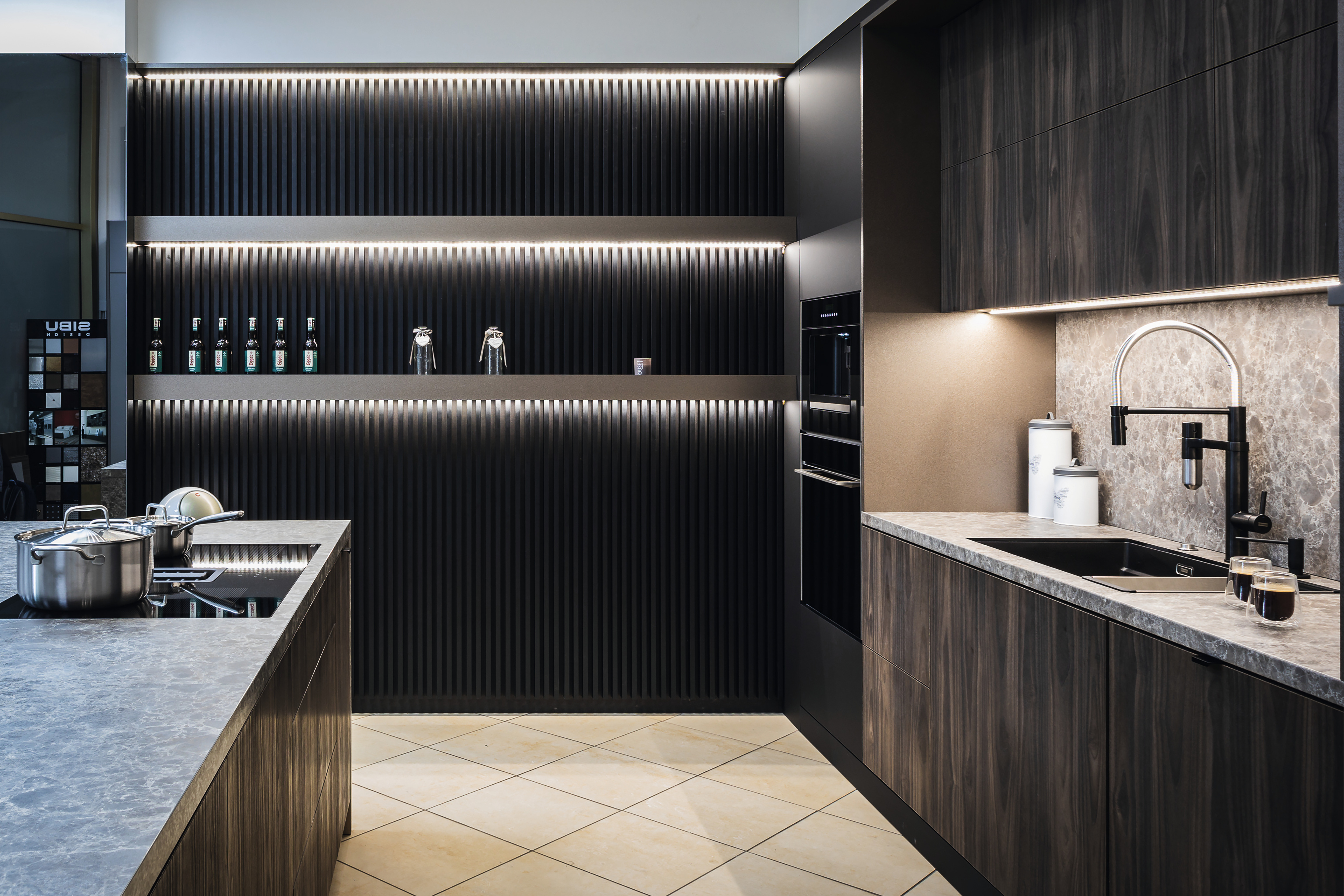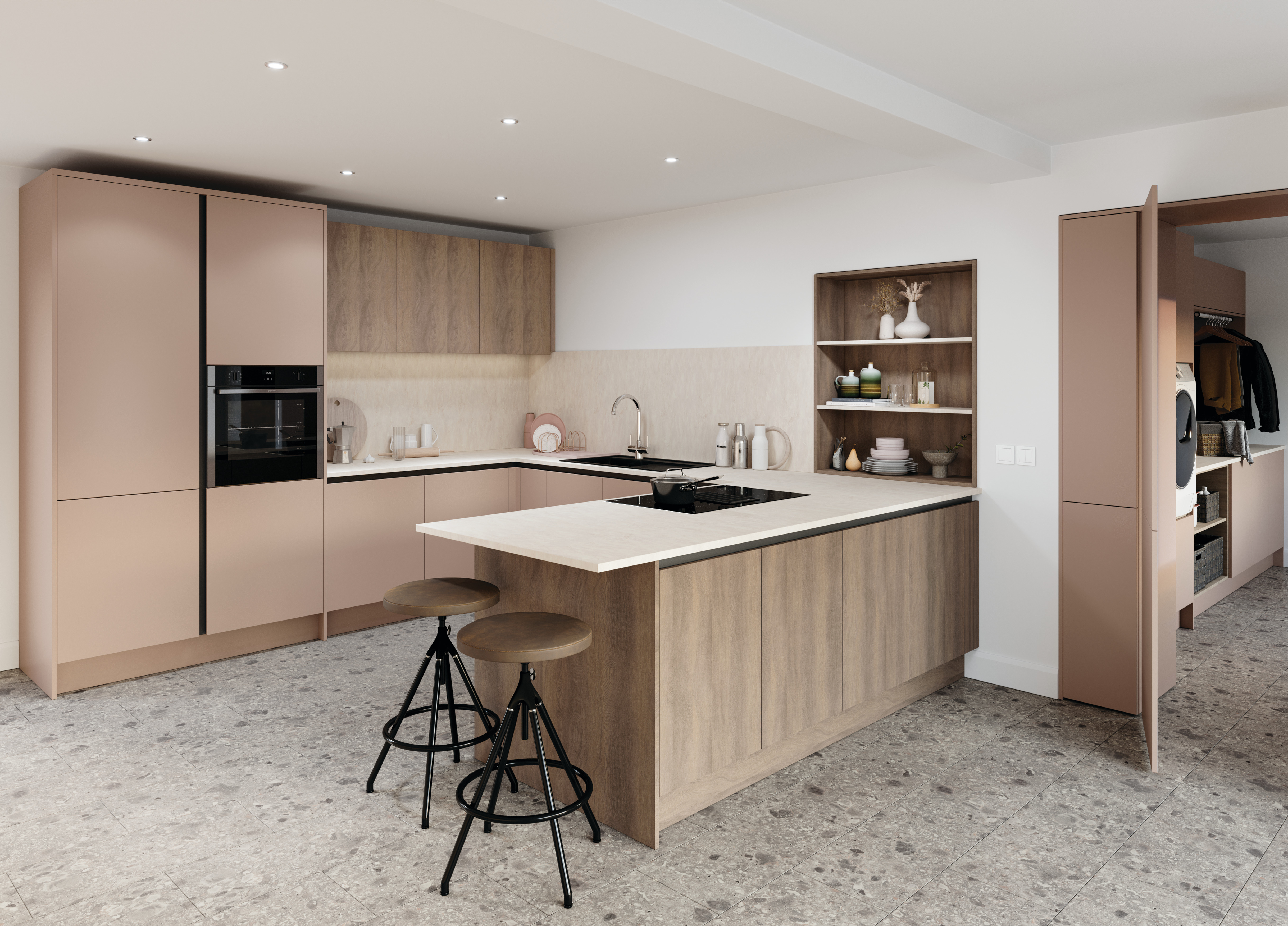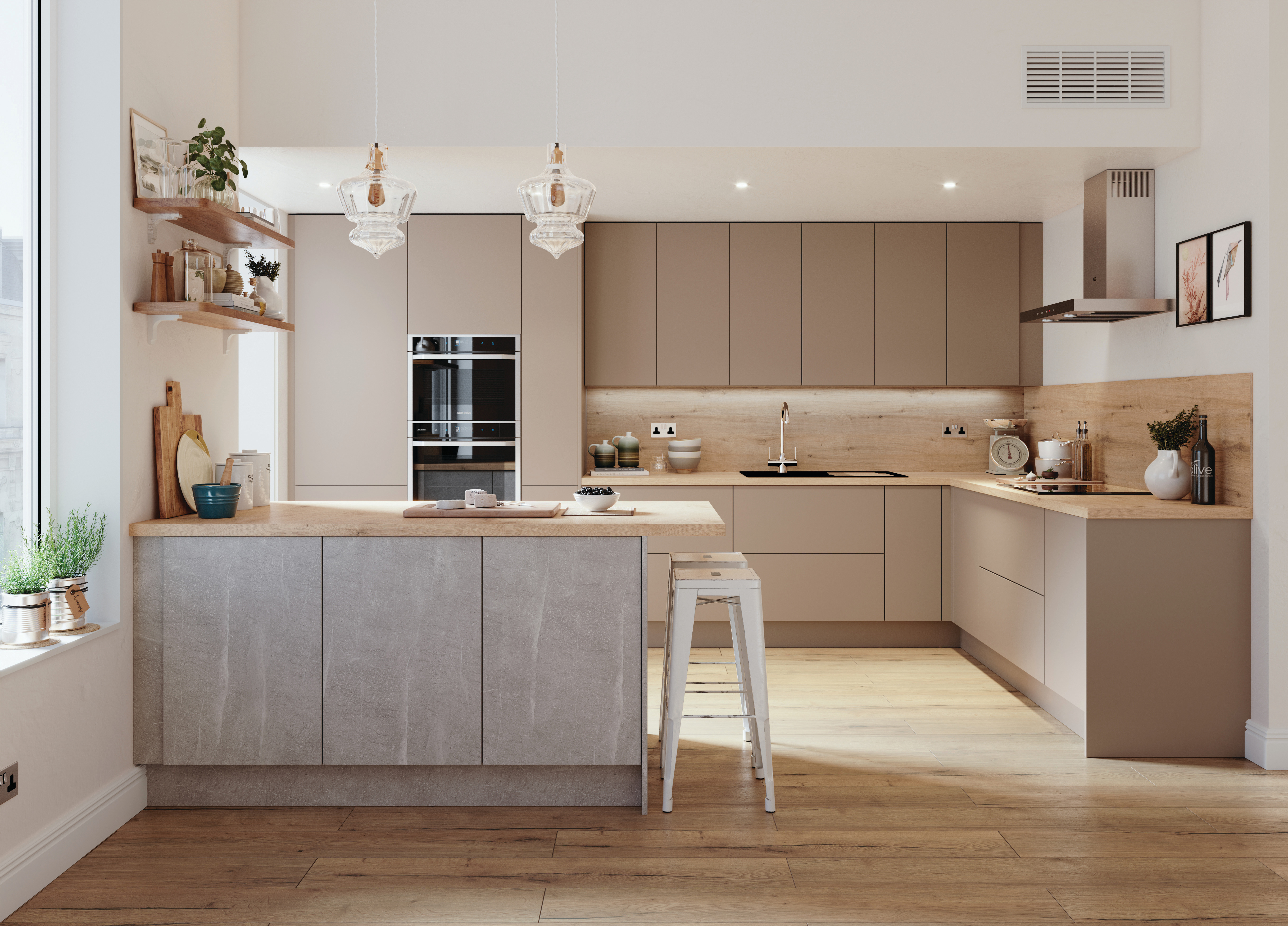
Choosing the right worktops is a key part of designing your dream kitchen. There are many different factors to consider, from deciding on the perfect finish to finding the right splashback to complement the look. But don’t forget about the importance of your worktop profiles. Countertop edges are a vital element of the overall design of your kitchen, not just in terms of aesthetics, but functionality too.
With a wide range of counter edge options available, finding the right one for your space may feel like a challenge. To make the decision easier, we’ve put together this worktop edge profiles guide, looking at the pros and cons of some of the most popular profiles and considerations to make when choosing a counter edge for your kitchen.
Article by: Anna Gibson , Product Manager, EGGER UK & Ireland
What is a worktop edge?
As the name suggests, a worktop edge refers to the design and shape of the worktop’s outer edges. There are a wide variety of options to explore, from smooth and rounded to sharp and sleek. They are of course important for the overall aesthetic of your kitchen, but edges can also have practical purposes. For example, if you have a small kitchen you may choose a certain countertop edge as it works better in tight spaces.
The right edge profile can enhance your kitchen’s style, improve safety, and even extend the durability of your worktop, so it’s important to carefully consider all the options available.
Kitchen worktop edge profiles: Pros and cons

Worktop edges come in a variety of shapes, each with their own unique advantages and disadvantages. Here we’ll look at seven of the most common types of worktop edge profiles and list the pros and cons of each, so you can make sure you’re fully informed before choosing a counter edge style for your kitchen.
Square edged worktops
One of the most popular worktop edge profiles, square edged worktops are characterised by its clean, straight lines and sharp corners, making for a sleek and versatile design. It is a common choice for modern kitchens, but it works just as well surrounded by classic interiors.
We have a fantastic selection of square edged worktops to choose from at EGGER, including a thin 25mm square edged worktop , with a stunningly sleek design, and a feelwood 38mm square edged worktop , ideal for those looking for a square edged profile with a more natural appeal. They can be used in a wide range of spaces, so whether you’re looking for kitchen worktops, tabletops, worktops for washbasins, or even reception counters, we provide lots of different options. Both of these worktops are available in various decors, so you’re sure to find the perfect fit for your project at EGGER.
Pros:
- The simplicity of the design makes square edged worktops straightforward to install.
- The versatile design makes this edge profile blend seamlessly with a variety of interior styles, but it especially complements contemporary and industrial-style kitchens.
- Unlike more distinctive edges, such as ogee profiles, square edges have a timeless appeal, meaning they won’t become outdated. This is an especially important consideration if you plan on selling your property in the future, or if you’re house flipping.
- This profile offers the largest usable surface area, making it one of the most practical choices.
- Square edged worktops are known for their durability. This is especially the case for EGGER’s selection of worktops as they are crafted from heat- and impact-resistant surfaces, plus they come with a UV lacquer coating which provides a protective layer against spills and moisture.
- Maintaining the look of a square edged worktop profile is easy as there are no intricate nooks and crannies to clean, unlike more intricate profiles. EGGER’s selection of square edged worktops also have stain-resistant properties for even easier cleaning and maintenance.
Cons:
- Without a protective layer, some square edged worktops may be more vulnerable to damage over time. Rest assured, all of EGGER’s square edged worktops come with a protective UV lacquer coating and durable ABS edging for maximum protection.
- With certain materials, water can seep into the seams of a square edged worktop which can eventually lead to deterioration. This shouldn’t be an issue with correctly installed EGGER worktops, as the UV lacquer coating is designed to protect the surface from water and moisture damage. To find out more about protecting your new worktops from water damage, make sure to read our EGGER worktops processing instructions document .
Postformed edge worktops
Looking for a worktop edge with a seamless finish? A postformed edge profile is the perfect option for you. Postformed edges are a rounded variation of square edges, made by wrapping laminate material all the way around the counter edge radii. This leaves the worktop with a smooth, rounded design which works well in a wide range of settings.
We have a fantastic postformed edge worktop on offer at EGGER. Designed with a substantial 38 mm Eurospan chipboard, this worktop can be used as a kitchen countertop, tabletop, and as a reception counter. Our postformed edge worktop is low maintenance and durable, making it a practical choice. And with the ability to coordinate splashback panels with this countertop edge profile, you can create a sleek and cohesive look in your kitchen.
Pros:
- Postformed worktops are sturdy and durable. EGGER’s postformed worktops are especially hard-wearing as they come with a unique high-density protective layer underneath the laminate edge, making them more resistant to damage.
- As there is a laminate layer over the edge, postformed worktops are smooth and safe without any sharp edges. This makes them a good choice for both families with young children and for more compact kitchens where you’re more likely to bump into the counters.
- Like square edged worktops, postformed edges are versatile in design and can complement both traditional and modern kitchens.
- This worktop edge profile is generally a cost-effective option compared to more intricate edge styles, which can be more expensive to make and install.
- The seamless edge wrapping in this design minimises the risk of water seeping into the core material and causing long-lasting damage.
- They are easy to clean and maintain as there are no sharp corners or grooves for dirt and grime to accumulate.
Cons:
- Postformed edges are primarily associated with laminate and are less common in stone or wood worktops. However, at EGGER you can still customise your postformed edge worktop in a variety of decors, so you should be able to find a finish which suits your interiors.
- While this type of edge is not very susceptible to damage, chips and cracks can be more noticeable if they do occur due to the rounded edge design. This shouldn’t be a problem if you invest in premium quality and durable postformed edge worktops, like the ones here at EGGER.
Bullnose edge worktops
A bullnose edge worktop has a completely rounded edge, without any sharp corners. The fully rounded edge of this design creates a smooth and continuous curve. The bullnose comes in two different styles: the half bullnose edge, which is just rounded at the top, and the full bullnose edge, which is rounded at the top and the bottom.
Pros
- The rounded shape of this edge reduces the risk of chips and damage, which you can get with sharper designs that aren’t adequately protected.
- These soft edges can also be useful in busy kitchens where you may find yourself bumping into worktop corners more often.
- The rounded profile of the full bullnose eliminates sharp edges, making it a safer choice for households with children.
Cons
- The bullnose design can look a little bulky, which does not best suit minimalist interiors or more compact kitchens.
- Spills can run over the rounded edge more easily.
- This profile is less common in certain materials, so you may struggle to find a bullnose edge in a finish you love.
- While bullnose worktops are less susceptible to chips and dents, the fully rounded edge can make them more noticeable if they do occur.
Pencil edge worktops
A pencil edge worktop features slightly rounded corners but still keeps a flat surface and does not slope like a bullnose edge. Like the bullnose, there are two distinct types of pencil edge available: the single pencil edge, which only has rounding on the top corners, and the double pencil edge, which has rounding on the top and bottom edges. In shape it is relatively similar to square edged worktops, but without the sharp corners.
Pros:
- The rounded edges can make them a safer choice for families with little ones.
- The slight curve makes this edge less prone to chipping compared to some sharper edges.
- They are easy to clean and therefore don’t accumulate as much dirt as other more intricate edges.
Cons:
- They are relatively simplistic in style, and may not be the best option for those looking for bold, statement-making countertops.
- With double pencil edges, the rounded bottom edge means that countertop spills can be more likely to leak into the cupboards underneath rather than spill directly on the floor.
- Depending on the material used, pencil edges can be a more expensive option.
- Pencil edges can make a countertop appear thinner, which may not suit your space if you’re looking for a more robust-looking countertop.
- Like bullnose edge counters, chips and dents can be more noticeable on pencil edge worktops due to their rounded edge.
Bevel edge worktops
Worktops with a bevel edge have a 45-degree angled cut along the edge to create a slanted shape. Just like pencil and bullnose edges, you can get single and double bevel edges, with the single just having a cut along the top edge and the double having an angled cut along both top and bottom edges.
Pros
- There are a wide variety of bevel designs on the market, ranging from subtle to more pronounced slants, making them a versatile choice.
- The angled slant of a bevel edge can create a sense of depth and dimension, so it can be a good option for a statement worktop.
Cons
- Due to requiring more complex cutting techniques than many other worktop edges, they can be on the pricey side.
- The angled edge can sometimes trap dust and debris, which may mean more frequent cleaning.
- Although not the sharpest countertop edge available, they can still feel sharp to the touch depending on the material and angle of the cut.
- The angled edge may show signs of wear over time, especially with frequent use.
Sharks nose worktops
This worktop edge profile has a distinctive tapered design. The top of the rounded edge protrudes from the main worktop and thins out, creating a thin slanted profile. It unsurprisingly gets its name from resembling the shape of a shark’s nose.
Pros
- This is a very distinctive look and could be a good option for those looking for a statement countertop.
- The thin design can be a good space-saving illusion for smaller kitchens.
- The cutting-edge style can make it a good option for a minimalist kitchen.
Cons
- This is one of the pricier worktop edge profiles.
- As the protruding edge is so thin, it can be more susceptible to damage.
- This is a very distinctive countertop and not to everyone’s taste. If you plan on moving in the future, or you’re flipping a house to sell, it may be safer to go for a more versatile and timeless style.
- The sleek look of this style makes it a poor option for more traditional kitchens.
Ogee edge worktops
Another distinctive worktop edge profile is the ogee edge. This edge features a two-part curve, which starts as a concave curve and follows into a convex curve. Many think of the edge as having an S-shaped curve. You can also get a version of this edge known as the double ogee, which comprises one S-shaped curve after another.
Pros:
- The ornate and sophisticated style of this worktop edge profile can lend itself well to classic, high-end kitchens.
- The curves can help to minimise visible signs of wear and tear, particularly in stone materials.
Cons:
- As it is a more ornate countertop edge, it can be quite expensive.
- The intricate curves of the design can trap dirt and make it difficult to clean.
- The ornate style can work well in classic kitchens, but it often looks out of place when surrounded by modern interiors.
- Not all materials are suitable for ogee edges, so it can be hard to customise an ogee edge worktop to make it truly your own.
Considerations when choosing worktop edges

Interior style
To create a cohesive look, you need to consider how your worktops and worktop edges will fit in with your wider interiors. Don’t know which edges suit which style best? We’ve created a handy table to help you find the perfect EGGER worktop edge for your space.
| Interior style | Key characteristics | Best worktop edge |
| Contemporary |
|
EGGER 25mm square edged worktop
|
| Industrial |
|
EGGER 25mm square edged worktop |
| Minimalist/Shaker-style |
|
EGGER postformed edge worktop |
| Scandi-style |
|
EGGER 25mm square edged worktop |
| Transitional |
|
EGGER postformed edge worktop |
| Farmhouse |
|
EGGER 38mm square edged worktop |
| Mid-century modern |
|
EGGER 38mm square edged worktop |
| Cottage |
|
EGGER 38mm square edged worktop |
| Coastal |
|
EGGER postformed edge worktop |
| Traditional |
|
EGGER 38mm square edged worktop |
Other considerations
Finding a worktop edge profile you love the look of is key, but make sure to bear in mind more practical considerations, too. After all, you want your space to look good, but above all else you want it to be liveable.
Make sure to consider each of the following factors before choosing your new worktops:
Durability: Worktops are a big investment, so you should choose one with an edge that will last. Keep in mind that thinner profiles, such as sharks nose edge worktops, may be more prone to wear and tear over time.
Space: You should think about how a certain edge will look in your space. For example, if you have a small kitchen, a thinner edge is a better choice, as is an edge with rounded corners to prevent injuries in tight spaces.
Safety: For families with young children, rounded edges like postformed are safer as they reduce the risk of injury.
Hygiene: More intricate edges, such as ogee edges, can take longer to clean as dirt and grime can get trapped. Smooth rounded surfaces like postformed edge worktops tend to be the easiest to clean.
Future interior changes: If you like switching up your style a lot, you should consider choosing a versatile counter edge style, like a square edged worktop, so it will perfectly complement any future changes you plan on making.
Selling up: Versatile edges are also a good option for those who plan on selling their property in the future, as they have the widest appeal.
Choosing the right worktop edge profile can add the perfect finishing touch to your space. Whether you’re aiming for a contemporary look or a family-friendly design, the right edge profile can elevate your kitchen’s functionality and appeal. From sleek square to smooth postformed, there is an edge profile to suit every taste.
Make sure to explore EGGER’s collection of worktops , where you’ll find a range of edge profiles available, from chic 25mm and 38mm square edged worktops to sleek postformed edge worktops . Looking for more advice before buying? Head to our worktops resource centre for more handy guides on finding the right worktops for your home.
Support
This article is for informational purposes only. If you are searching for the information about specific EGGER products, please visit our knowledge hub .
